
It should come as no surprise to you that video content is everywhere.
Video engagement is high, the demand is increasing, and Google surfaces them on over 17% of all searches.
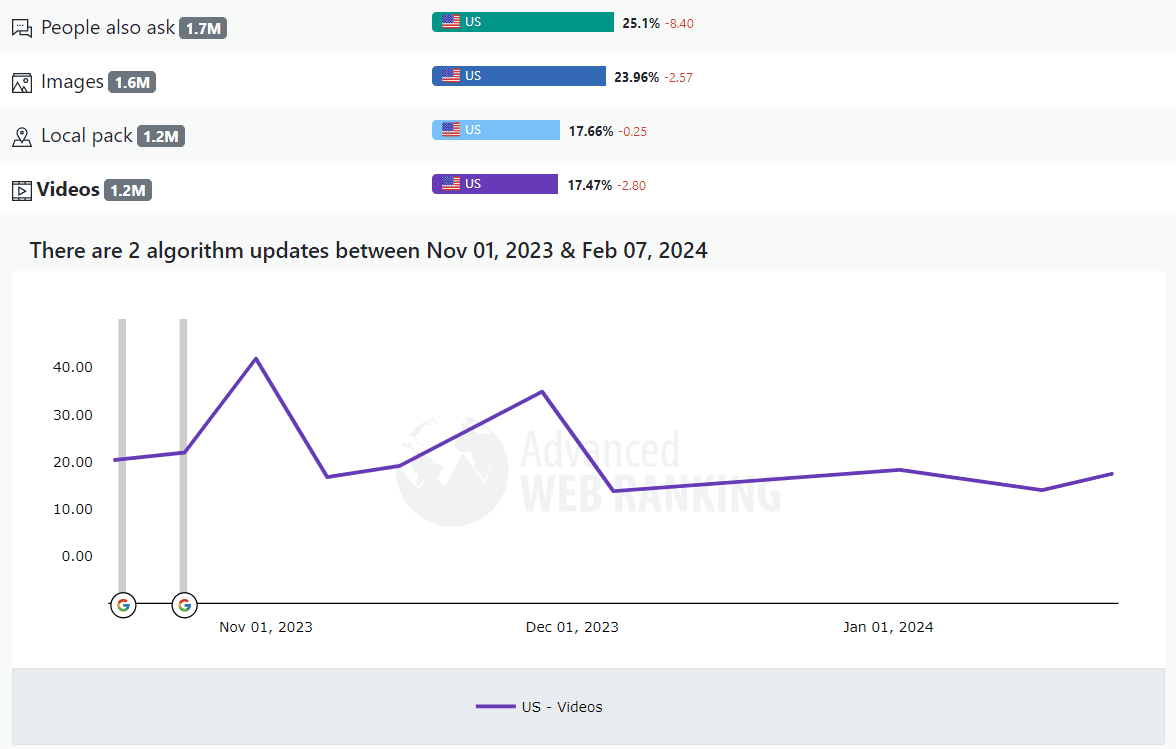
No matter the topic, there’s a video for it. And if you haven’t already, it’s time to embrace this more visual content format.
YouTube is probably the first platform and place to search when you think of online video. Your site can benefit from an SEO strategy on all search engines you try to get traffic from, so it should be no surprise that YouTube is no different.
YouTube is the biggest video platform and the second-largest search engine (after Google).
This guide will show you exactly how you can make YouTube work for you and drive more traffic to your videos.
How YouTube works
When you visit YouTube's homepage, you’re likely overwhelmed by all the videos the site is shouting for you to watch.
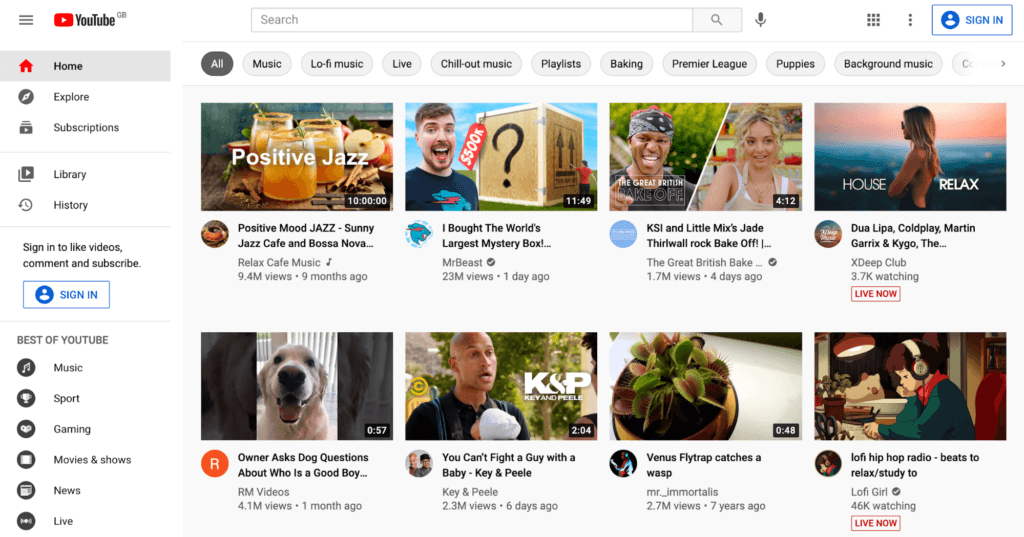
The videos shown to you frequently change, meaning you’ll see a host of different videos throughout the day.
But why are these videos shown to you?
There are three factors to consider for why YouTube recommends a video to you, which are:
Relevance
Engagement
Quality
Not so different from how Google determines search results, is it?
As YouTube is a search engine, title tags and descriptions help it understand what your content is about.
The largest difference between Google and YouTube is that rather than links, YouTube relies a lot more on engagement.
If a lot of users engage with your video, it's a signal the users feel the video is a quality piece of content. As a result, YouTube will suggest the video to a broader audience.
It’s important to ensure you're optimizing video content for YouTube, so if you don’t know where to start, we have you covered.
We’ll go through how you can do this, step by step, below.
Start with research & SERP analysis
Every SEO strategy shares the same initial stages. This is no different for a YouTube SEO strategy.
It all begins with keyword research, followed by a SERP analysis.
Keyword research is essential to help you both prioritize and optimize for the right terms. Getting this correct sets you off on the right foot.
YouTube Autocomplete
Start typing, and YouTube will predict what you’re searching for based on popular searches and your search history. Immediately, you’ll get insight into popular terms, which you can then use to help generate content ideas.

Check competing channels
It’s always a good idea to keep on top of what your competitors are doing. This way, no changes should come as much of a surprise.
You can also analyze the content competing channels are creating to help generate ideas for your channel. This is especially useful if a competing channel has a large view count.
You can view popular videos in a specific channel by sorting their video views by the most popular.

But don’t forget to also look at the newest videos. They may not have had the chance to gain as many views as older videos, so you might overlook trending content.
Looking at competing channels gives you a good indication of what kind of things are popular, which you can then use to generate ideas when looking for keywords.
If you have a list of your target audience's popular channels, this helps ensure you create content you know users want to engage with.
Don’t worry if you’ve yet to find a list of competitors.
Start watching some videos in your niche. You’ll find YouTube’s algorithm will start to suggest more videos and channels to you.
Not only does this help with your competitor research, but you can see firsthand how YouTube’s engagement algorithm works and how it can benefit you.
YouTube Keyword Research
Just like you can get keyword research tools for Google, there are some for YouTube also.
My favorite is Ahrefs Keyword Explorer; its functionality is very similar to the keyword database Ahrefs has for Google searches.
To get started, enter a broad keyword and select YouTube from the dropdown list.

Next, go to the "Phrase match" report to see what people search for that includes your term.
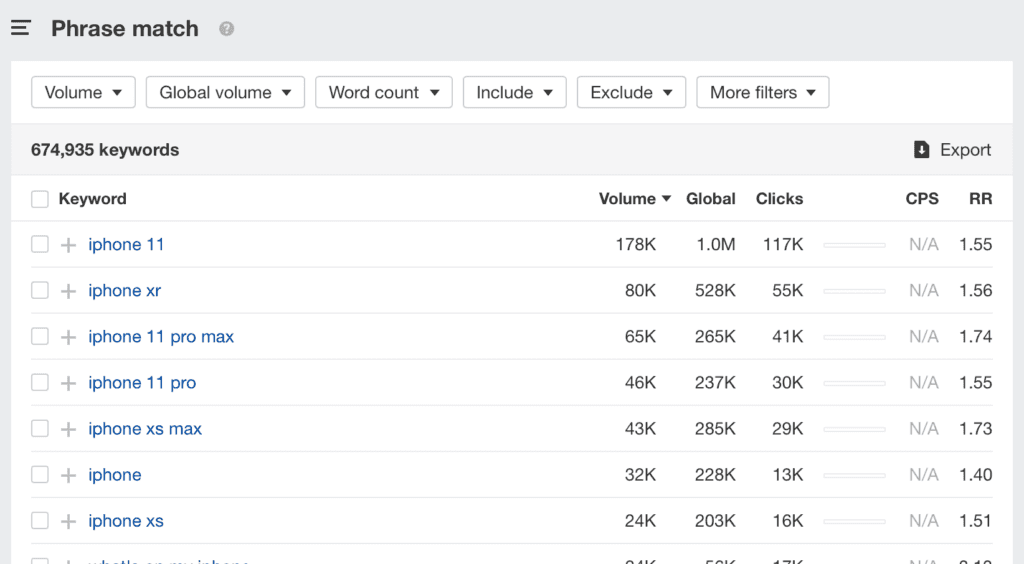
Scan the list and narrow down what you’re looking for by selecting a high-volume topic you want to cover. In this case, I’m choosing "iPhone 11."
You’ll then go to the overview page.

At this point, I usually go back to the reports on the left and go to the phrase match report.
Then start picking out some potential video ideas from the returned table.

Next, head over to the "Questions" area of the left sidebar and do the same again, and select potential keywords you could target with videos.

SERP Analysis
We’ve generated some ideas from autosuggest and keyword research; next, let’s research using a slightly different angle.
This time, we will find keywords based upon what people search for on Google and look for the video SERP features.
Why?
Google shows YouTube videos on search results, and it does this for some highly searched terms, so this is another great avenue for getting views to your video content.
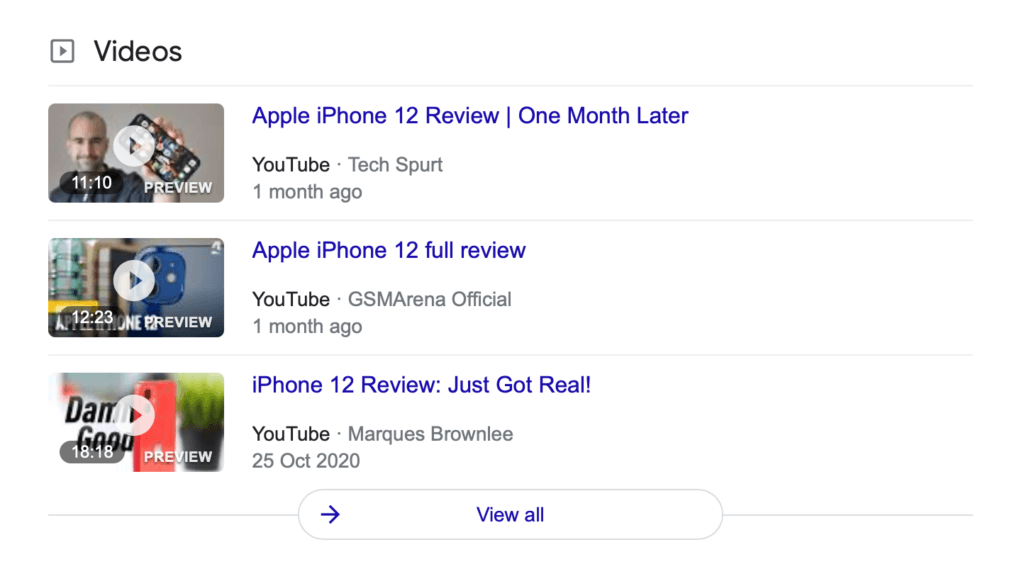
To do this, you’re going to need to have a keyword set for Google, preferably an informational one.
To spot these opportunities where Google shows a video SERP feature, you need to use a tool that tracks SERP features. Advanced Web Ranking is excellent for this.
In Advanced Web Ranking, after you’ve uploaded your keyword set, go to the Ranking > Keyword report.
Once there, use the SERP features dropdown at the top of the page and filter for Videos.
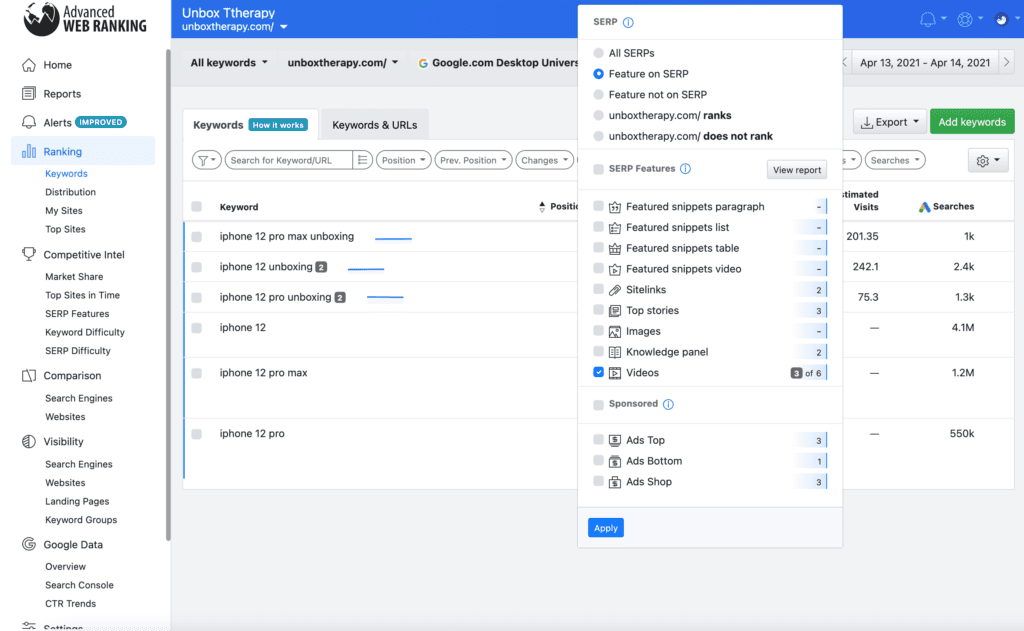
And there you go; the returned list will provide you with keywords to target with your videos if you want to show up within Google.
Create an engaging & optimized video
Once you’ve created your video, there is nothing more satisfying than knowing that your audience is enjoying it and that your time and hard effort hasn’t gone to waste!
There are several ways your audience can engage with your video on YouTube that give you an indication of its success.
Engagement signals
One way to understand a video’s success is audience retention — how much of a video someone watches. The closer your audience gets to watching 100% of the video, the better.
While you will benefit from this, it’s ultimately because the longer someone watches your video, the more ads they are likely to see, meaning more profit for YouTube.
Optimal video length is something for you to figure out.
Getting the right video length increases the chances of someone watching the entire video, so it’s a good idea to experiment. If your users engage with longer videos, you can play with creating longer-form content.
However, there’s more to it than just audience retention.
Audience engagement falls under several activities, including:
Comments
Subscriptions
Shares
Thumbs up
The more of these engagement signals, the more YouTube will reward your success and push your video to a larger audience.
That means when you hear a YouTuber asking you to like and subscribe, it’s for a good reason, despite how annoying it can be.
Mention your target keyword in the video
Video may feel different than the text content you create, but they are similar and should follow a similar structure.
Some things to consider are:
Use the same language as your audience. For example, don’t use jargon if it's likely to be words your audience wouldn’t use. Use your keyword research to inform the kind of words your audience uses to describe things.
If you find your audience asks specific questions around a topic, break your video into logical sections that answer those questions. For example, if you’re doing a review of an iPhone XS and see users search for "unboxing," "drop-test," and "camera quality," use that to structure your video accordingly.
You’re probably thinking the above sounds familiar, and you’d be right. It's not too different from the SEO fundamentals you’re used to when optimizing for Google search.
Optimizing when uploading
Why go to the effort of making a video if you’re not going to follow through with optimization?
When you come to uploading, there are several things to check off before you can rest assured your video will perform as well as possible.
These steps include:
Add a title
Add your target keyword in the title naturally. While it isn't guaranteed to help you rank, it could impact the click-through rate.
Add a description
Write an engaging video description. Keep this short and concise, but make sure it covers all essential elements of the video.
When you land on a video, only the first 100 characters or so tend to be shown above the “show more” link, according to estimates by HubSpot. However, the exact amount varies based on where your video is displayed.
The better these 100 characters align with the video content, the more your audience will know what to expect and be less likely to drop off.
Some top tips are:
Include relevant keywords early,
Keep it brief. A minimum of 250 words with a maximum of 1000. The shorter, the better, as people are here to watch, not read,
Use language and keywords that your audience uses.
Tag your video with keywords
When it comes to keywords, not only do you help YouTube to recognize what your content is about, but you do the same for your audience.
Tag your video with popular but relevant keywords. YouTube is a smart platform and, in turn, will link these to similar videos, meaning you’ll reach more people.
Relevancy is key here. If you tag your video with unrelated keywords, YouTube and your audience will give your video less consideration..
Add a category when uploading
An easy way to increase your views is by assigning a category to your video.
Go to "advanced settings," and you’ll come across a whole range of categories.
Your video will be more likely to appear before an audience searching within that category when you assign a category to your video.
Your video may also turn up in different playlists, increasing its chances of being seen by a wider audience.
Add a custom thumbnail
Imagery works wonders, as it can help your video stand out. In turn, this entices the audience to click through to your video, increasing the click-through rate.
One tip is to make sure the thumbnail relates to the title, so you may need to add text to the thumbnail. Keep this minimal and as enticing as you can.
Thumbnails are something you should experiment with, as a great thumbnail can massively impact how much your video is viewed.
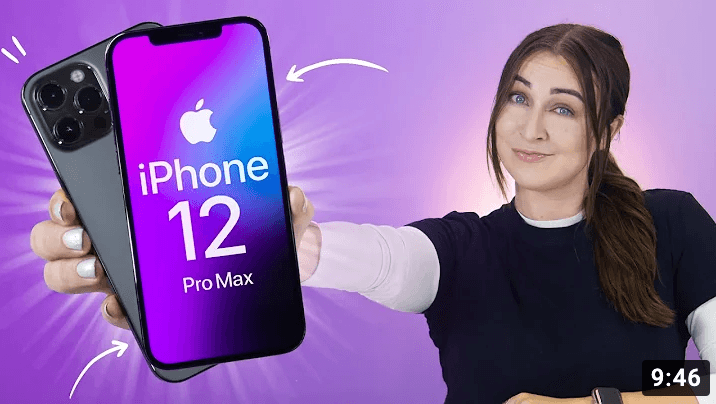
YouTube states that 90% of the highest performing videos on YouTube have a custom thumbnail.
Add an SRT file for subtitles and closed captions
YouTube gives you the option of including subtitles in your video. Use this!
While this is beneficial for those with hearing impairments, stats say a video is more likely to be viewed in its entirety when captions are available.
Add cards and end screens
You may notice an image of the letter "I" within a white circle in the top right corner.
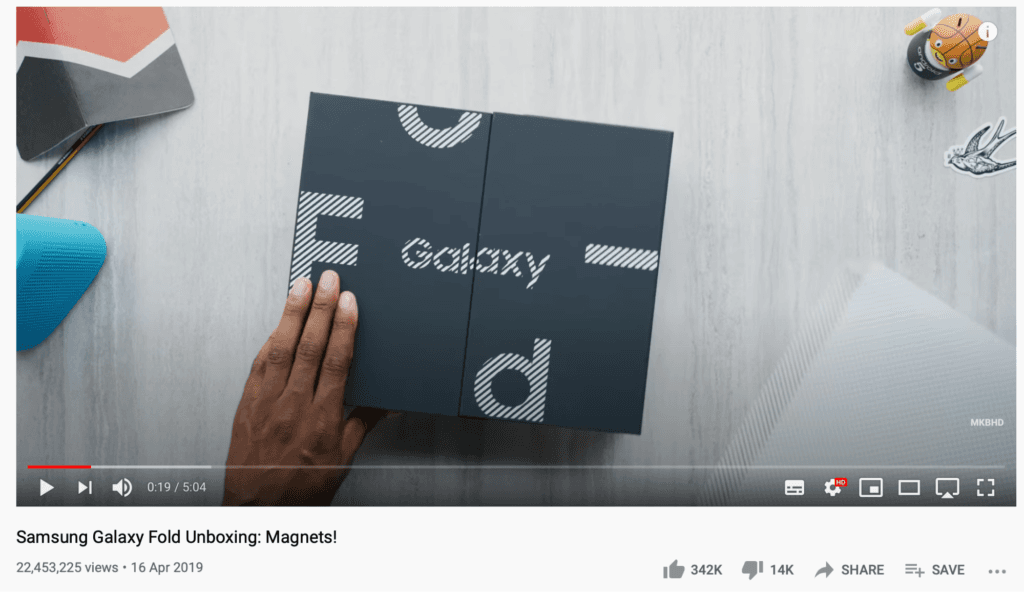
This is called a card.
Each card is actionable, and you can have five per video.
The card types are:
Channel card - this promotes another channel of your choosing.
Associated website cards - your audience can view a related site of the video with this card.
Merchandise cards - have licensed merch? You can promote this on your video via this card.
Fan funding cards - this allows fans to donate to help you create more content
Poll cards - this allows you to ask a question and for your audience to vote the answer.
Video cards - this links to similar videos
The option to click a card is available throughout the entire video.
An end screen, on the other hand, pops up right at the end of your video. You can use this to promote other videos your audience may find interesting — an easy way to continue the audience engagement.
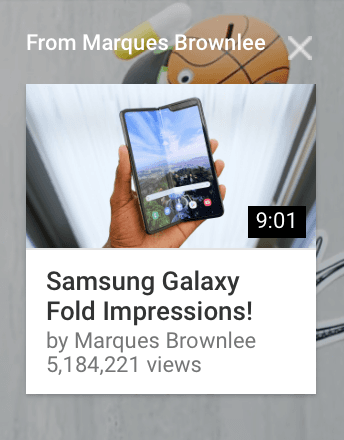
Promote
Like with any platform, it’s not easy starting with minimal subscribers. Once you do grow, you’ll experience the flywheel effect, and promotion becomes easier.
There are so many ways to promote your video that it’s worth giving each a go. What doesn’t work for some might work for you and vice versa.
To start with, try promoting through:
Forums
Popular forum sites such as Quora and Reddit have massive audiences, so take advantage of this sharing your video and adding to the conversation.
You mustn’t spam on these forums!
Seeing the same link repeatedly, especially if it has no relevance to the forum's topic, will likely have the opposite effect, put people off, and may get your account banned.
Instead, find a thread that relates to your video subject. Read the site's guidelines to make sure this type of promotion is allowed. In a few words, explain what the video is about and why it should pique your audience’s interest.
Then it’s up to the audience to decide whether it’s worth their time to click through.
Email marketing
As we all know, video is a brilliant content format for engagement.
And email marketing is a great channel for traffic, as it's one that you fully own.
The two go together exceptionally well by making an otherwise plain-looking email stand out.
If your video is compelling enough, it’s much more likely to be forwarded to someone else rather than a plain text email.
A top tip is to keep the video informative but as short and concise as possible.
There’s a time and a place for longer video content, but as we often check our email while at work, we want to see something that’s to the point and won’t take up our time.
A 20-minute video will likely have the opposite desired effect and be too time-consuming for the average person.
Email signature
If an email campaign doesn’t suit you, don’t forget about email altogether.
Try popping a link to your video in your email signature. Chances are, if you’re in an email conversation with someone, they’re already engaged and more likely to check out the link.
Blog
A blog is a great way to accompany your video and give that extra bit of context.
You could use it as a central part of a blog post, with text to accompany it. Or if it makes sense to link out to your video in a blog post, then do it!
Perhaps you’ve created an explainer video, and alongside this is an explainer article; this is the perfect opportunity to link out to your video.
Highly trafficked pages
If you’re hosting the video on a page on your site, make sure it’s one the page receives a reasonable amount of traffic.
It might work better on another page, but if that has a low amount of traffic, it’s going to take a lot longer to get that video in front of an audience.
The page doesn’t have to revolve around the video. By merely linking out to your video on high traffic pages, your video will be more likely to score a view. As always, the page/content does still need to be relevant to the video.
Playlists
Playlists are great because they automatically play one video after another.
Automatic video play could mean a great deal many more watches on your video each month!
Creating a playlist is easy.
A tip is to make sure the videos each relate to one another in some way to ensure relevancy. So simply pick a selection of similar videos and create a playlist.
Once you have your playlist, make sure to feature it on your channel page. It’s a quick and easy way for any newcomers to spot the video without the user having to search for it.
Linking to your new playlist in an email newsletter or relevant area of your site can help you reach a wider audience too.
Social ads
We all know that platforms like Facebook, Twitter, LinkedIn, and Instagram have a vast audience and social ads are a great way to take advantage of this.
By using a social ad to display your video, you’re instantly putting that piece of content in front of potentially hundreds of thousands of eyes.
It’s essential to know your audience and to target the video specifically to them. You may get lucky using the approach of advertising to anyone and everyone, but you’ll receive a much higher ROI by going down the targeted route.
A top tip that applies to any of the above is not to be spammy. It’ll have the opposite effect and deter people from watching your videos.
Measure YouTube search rankings
In addition to tracking video SERP features in Google, you can also use Advanced Web Ranking to track your position in the YouTube search.
For this, you need to select YouTube as a search engine inside AWR and add your list of YouTube videos for tracking.
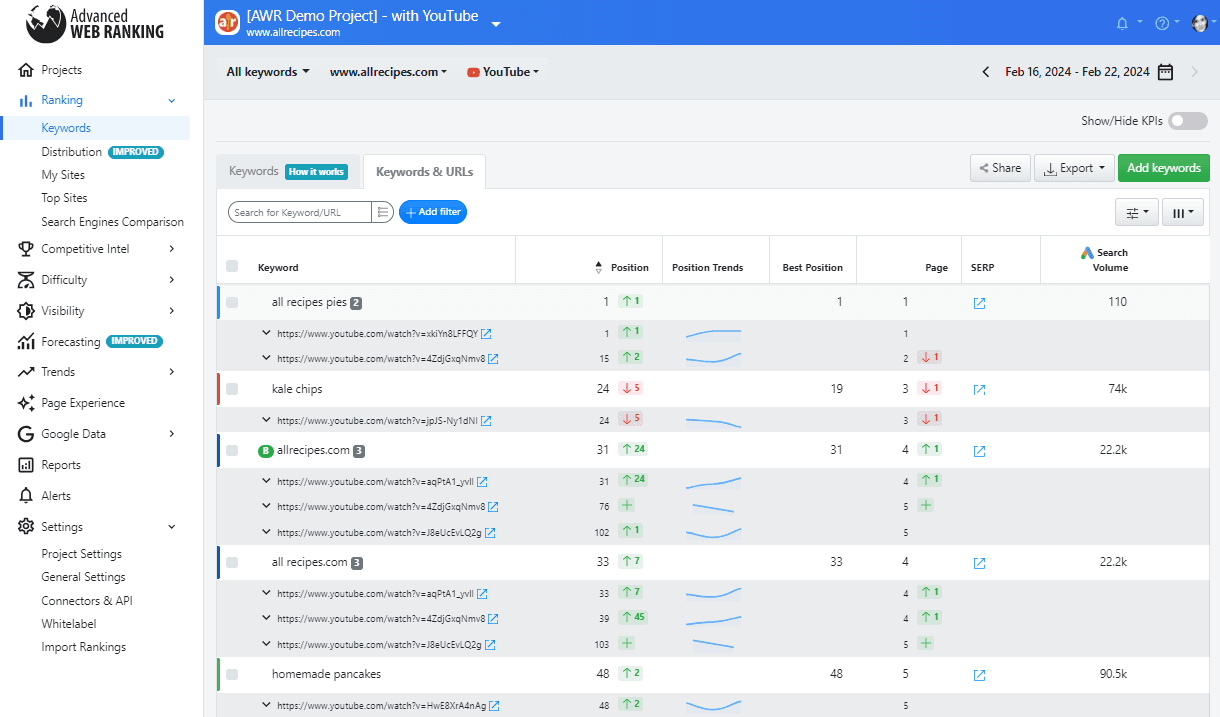
To see the actual YouTube SERPs just click on the icons on the SRRP column in the report above, or head over to Rankings > Top Sites > Date Comparison to see how YouTube videos change their positions over time.
If you need, you’ll be able to access the YouTube SERP snapshot from here as well.
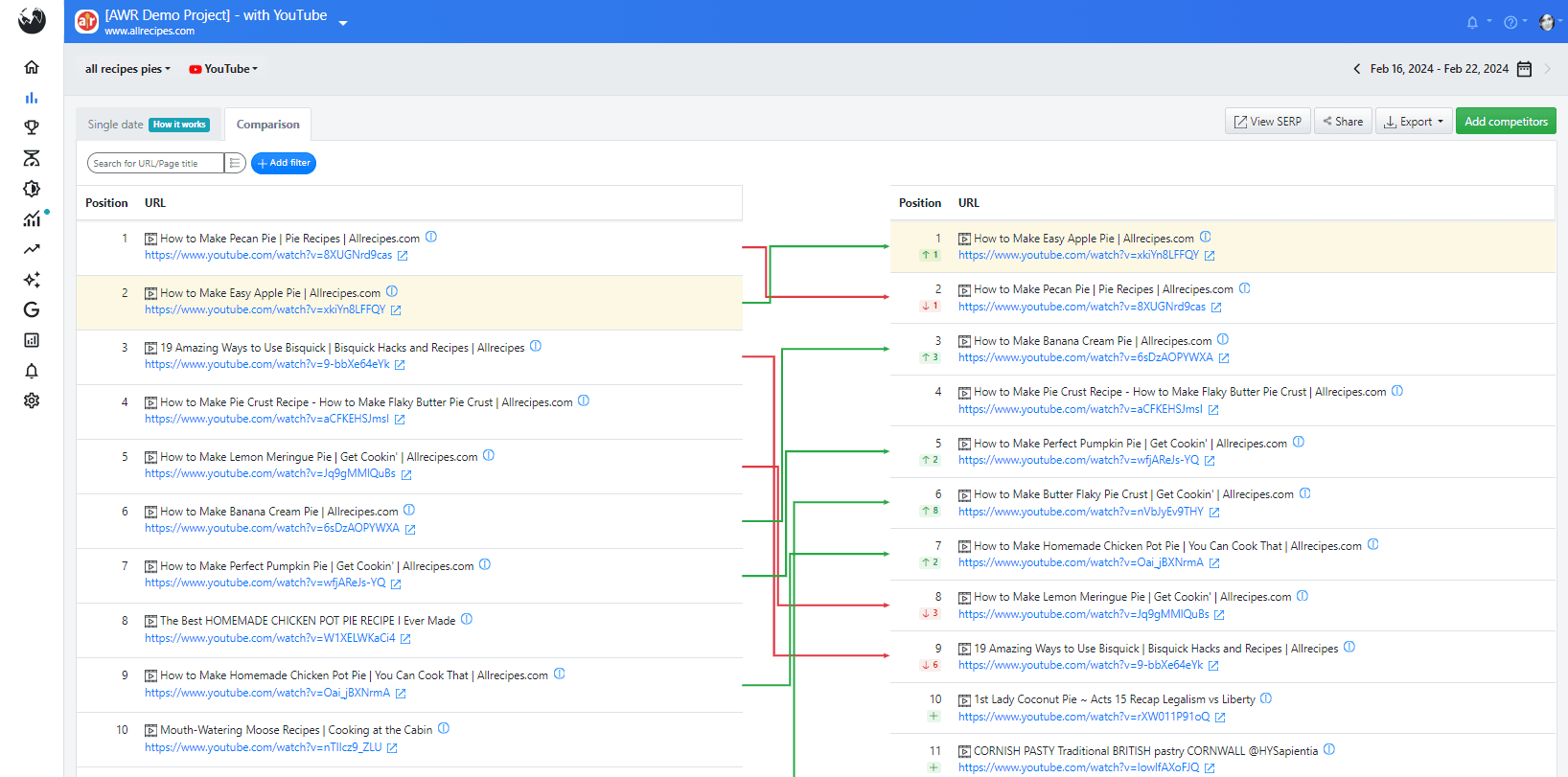
Handy YouTube tools
Fortunately, if you’re new to the YouTube game, there are plenty of tools to help you get started. Here's a couple I recommend:
TubeBuddy
Are you looking for a one-stop place to meet all your video SEO needs? TubeBuddy is your tool.
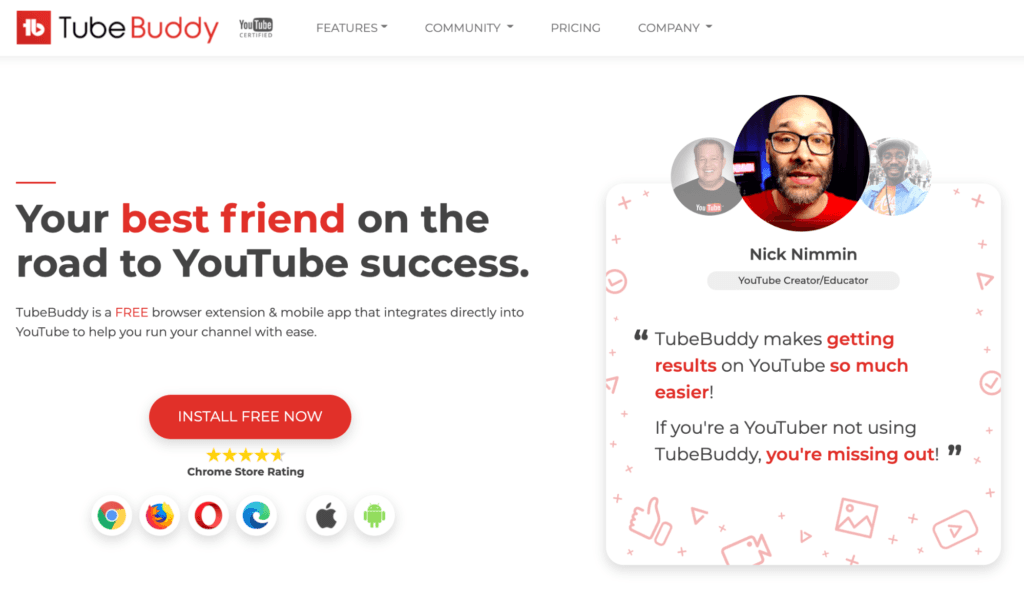
Not only can this tool help with the production and optimization of your video, but it can also help with the promotion side of things.
Rival IQ
A handy tool to help keep an eye on how your competitors are performing on YouTube, Rival IQ gives you an in-depth insight into how your competitors are performing, which in turn will help you make your content perform better.
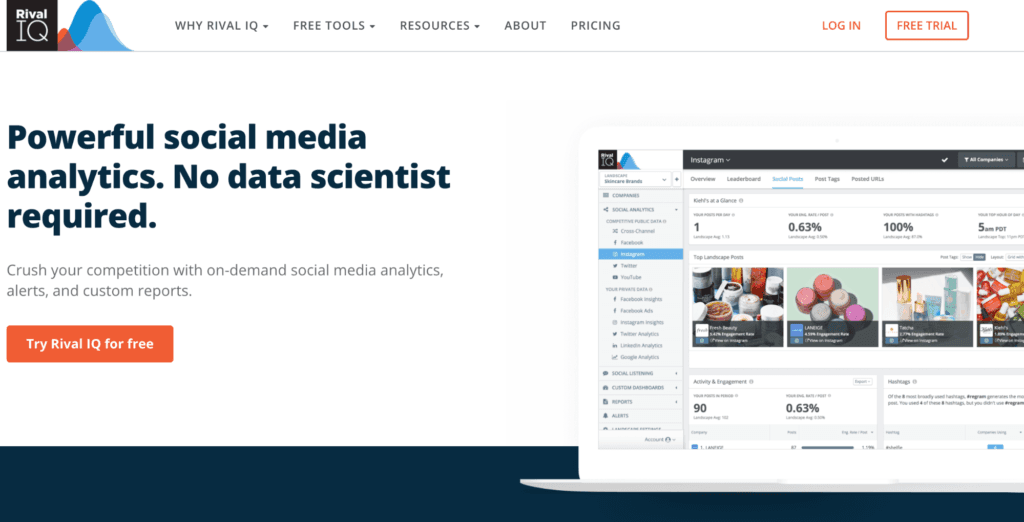
This tool gives you competitor insights and includes the option to notify you whenever they make an update.
Another handy benefit is that it also lets you know when and how often to post content to ensure your content is seen by as many people as possible and performs as best as it can.
Wrapping up
So there you have it; an extensive guide on how to optimize your videos for YouTube.
If you’re already a pro at putting together an SEO strategy, none of the above should come as a surprise to you. You’ll be familiar with most of the steps, already putting you miles ahead!
Be mindful that video content is just the same as written content in the sense that quality is key. If you’re putting out a video that simply isn’t good, it doesn’t matter how closely you follow the above steps; it’s never going to perform well. Start with research & SERP analysis.


